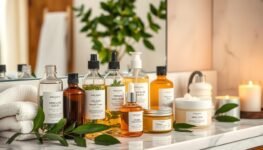
Your Guide to an Effective Organic Skincare Routine for Glowing Skin
Imagine if your skincare routine could boost your skin’s health and help the planet. By using organic and natural products, you can do just that. Many are now choosing organic skincare for its eco-friendly benefits. Products like those from Éminence Organics are even USDA Certified Organic1.
Exfoliating 1-2 times a week with natural items like oatmeal or kaolin can make your skin smoother2.
Key Takeaways
- Switching to organic skincare is kinder to your skin and the planet. It uses ingredients responsibly, fitting the natural and clean beauty standards.
- Using natural exfoliants like oatmeal or kaolin can help remove dead skin cells and reveal a smoother complexion2.
- Some products, such as those from Éminence Organics, are USDA Certified Organic1. This is key when picking organic skincare for your routine.
- Choosing a natural sunscreen with zinc oxide or titanium dioxide offers broad-spectrum protection without synthetic chemicals2.
- NATRUE-certified products have been checked by an independent group. This means they meet strict NATRUE standards2.
- Plant-based options like Jojoba Oil and Corn Starch are okay by NATRUE as silicone substitutes in cosmetics2.
- Mineral oils can be swapped for vegetable oils and waxes. These are better for the environment2.
Understanding Organic Skincare
Organic skincare uses natural ingredients to keep skin healthy. It’s good for your skin and the planet. Choosing organic means avoiding harsh chemicals and artificial scents that can harm your skin3.
Brands like Elemental Herbology make organic products inspired by Traditional Chinese Medicine. They use natural ingredients and avoid harmful pesticides. This helps protect the environment3. Eminence Organic Skin Care, Furtuna Skin, Bioeffect, and Caudalie also focus on natural, sustainable, and effective skincare4.
When picking skincare, think about your skin type. Dry skin likes oils like coconut and sunflower. Oily skin might need peptides and niacinamide to keep moisture in4. Natural ingredients like grape extracts and green tea are also good for your skin4.
Benefits of Organic Skincare
Organic skincare reduces skin irritation and improves health. It’s also better for the environment. By using natural ingredients, you help your skin and the planet3. For more tips, visit healthyshopperplacer.com to learn about natural skincare.
Key Ingredients to Look For
Creating a plant-based skincare routine means focusing on natural ingredients. These should hydrate, nourish, and protect your skin. A good eco-friendly skincare line includes various key ingredients for healthy, glowing skin. Natural oils like coconut and argan oil are great for moisturizing and hydrating5.
Botanical extracts and essential vitamins are also key. Ingredients like calendula, Vitamin C, and E offer many benefits. They soothe, protect, and even help with collagen production and fine lines6. Look for products with tea tree oil, green tea extract, and aloe vera for their antibacterial and anti-inflammatory effects6.
Here are some key ingredients to look for in your eco-friendly skincare products:
- Natural oils: coconut oil, argan oil, jojoba oil
- Botanical extracts: calendula, green tea extract, aloe vera
- Essential vitamins: Vitamin C, Vitamin E
These ingredients help create a balanced skincare routine. They promote healthy, glowing skin5. By choosing eco-friendly products, you reduce environmental impact and get the radiant skin you want6.
Creating Your Organic Skincare Routine
Starting a green beauty routine or a clean beauty routine means knowing your skin. Your morning routine should focus on hydrating and protecting your skin. At night, it’s all about cleansing and nourishing7.
Make sure to include steps like cleansing, toning, moisturizing, and maybe exfoliating. Knowing your skin type is key. It helps you pick the right products for the best results8.
A good green beauty routine or clean beauty routine can really change your skin. Using natural products and sticking to a routine can make your skin glow7. For more tips, check out healthy shopper placer.
- Choose gentle, natural ingredients like plant oils and essential oils.
- Stay away from harsh chemicals like parabens and fragrances.
- Exfoliate 1 to 3 times a week to gently remove dead skin cells8.
By following these tips and making your routine fit your skin, you can get a healthy, glowing complexion. This is part of yourgreen beauty routine orclean beauty routine7.
Cleansing: The First Step
Cleansing is key in any skincare routine, and organic skincare is no exception. It’s important to pick the right natural products. Start with a gentle cleanser that removes dirt and makeup without drying out your skin.
There are many organic cleansers out there, like gel, cream, and oil cleansers9. Each has its own perks and fits different skin types. For instance, oil cleansers are excellent for getting rid of dirt and makeup. Cream cleansers, on the other hand, add extra moisture9.
To clean your skin right, massage the cleanser on, rinse well, and gently pat dry9. This step not only cleanses but also gets your skin ready for what comes next. Some brands offer organic cleansers with top-notch plant-based ingredients10.
When picking an organic cleanser, avoid harsh chemicals and synthetic preservatives10. Go for products with natural ingredients that are kind to your skin. Using the right natural skincare products can make your skin healthy and radiant.
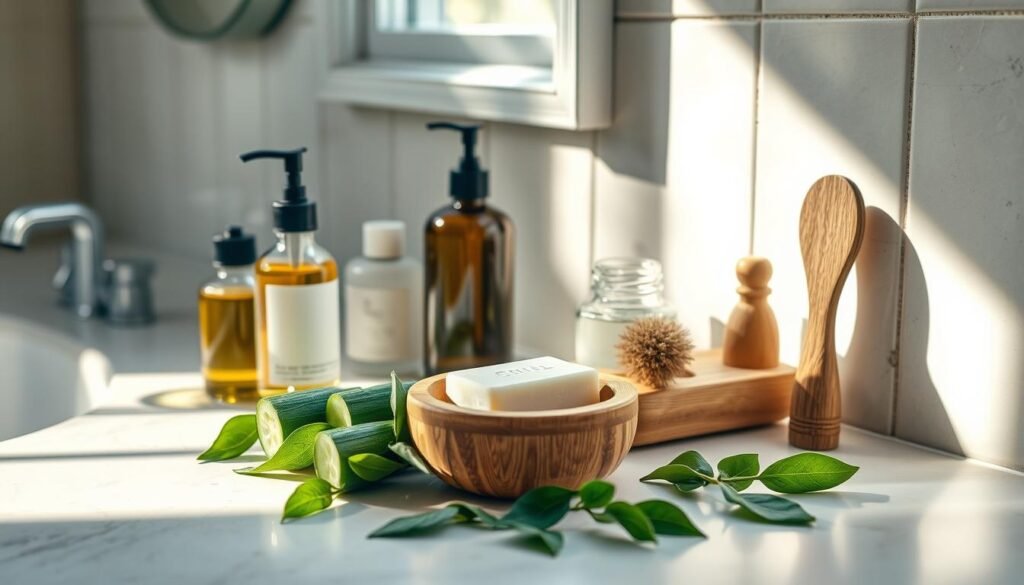
| Type of Cleanser | Benefits |
|---|---|
| Gel Cleanser | Suitable for most skin types, gentle and non-irritating |
| Cream Cleanser | Provides extra hydration, suitable for dry skin |
| Oil Cleanser | Effective at removing dirt and makeup, suitable for all skin types |
Exfoliation: The Secret to Radiance
Exfoliation is key in any skincare routine. It removes dead skin cells and improves texture. There are physical and chemical exfoliants. Physical ones are scrubs and brushes, while chemical ones use acids or enzymes like AHAs and BHAs11.
How often you exfoliate depends on your skin. Oily or acne-prone skin needs it 2-3 times a week. Dry or sensitive skin starts with once a week and adjusts as needed11. Regular exfoliation keeps your skin bright by removing dead cells, showing off your natural glow12.
Exfoliation improves skin texture, helps products absorb better, and makes your skin look more radiant12. Here are some tips to enhance your exfoliation routine:
- Exfoliate 1-2 times a week to avoid over-stripping the skin12
- Use a broad-spectrum sunscreen daily, after exfoliating, to protect your skin from the sun11
- Moisturize your skin after exfoliating to keep it soft and prevent dryness12
Adding exfoliation to your skincare routine and using eco-friendly products can make your skin look radiant and healthy11. Always listen to your skin and adjust your routine to avoid irritation or redness.
| Skin Type | Exfoliation Frequency |
|---|---|
| Oily or Acne-Prone | 2-3 times a week |
| Normal | 1-2 times a week |
| Dry or Sensitive | Once a week, adjust as needed |
Toning: Balancing Your Skin
Toning is key in a non-toxic skincare routine. It balances your skin’s pH, reduces inflammation, and prevents breakouts13. It’s also great for removing dirt, oil, and makeup, which is a must for city dwellers or those who wear makeup often13. Adding toning to your routine makes other products like serums and moisturizers work better and get absorbed more easily13.
When picking a toner, think about what your skin needs. For dry skin, choose hydrating and gentle toners. For oily or acne-prone skin, go for toners that fight acne13. Natural options like witch hazel or rosewater can be soothing and help balance your skin14. Knowing your skin type is important to pick the right toner and get a balanced skincare routine15.
Here are some benefits of toning in a skincare routine:
- Refines pores and restores pH balance15
- Removes excess dirt, oil, and makeup13
- Enhances the effectiveness of other skincare products13
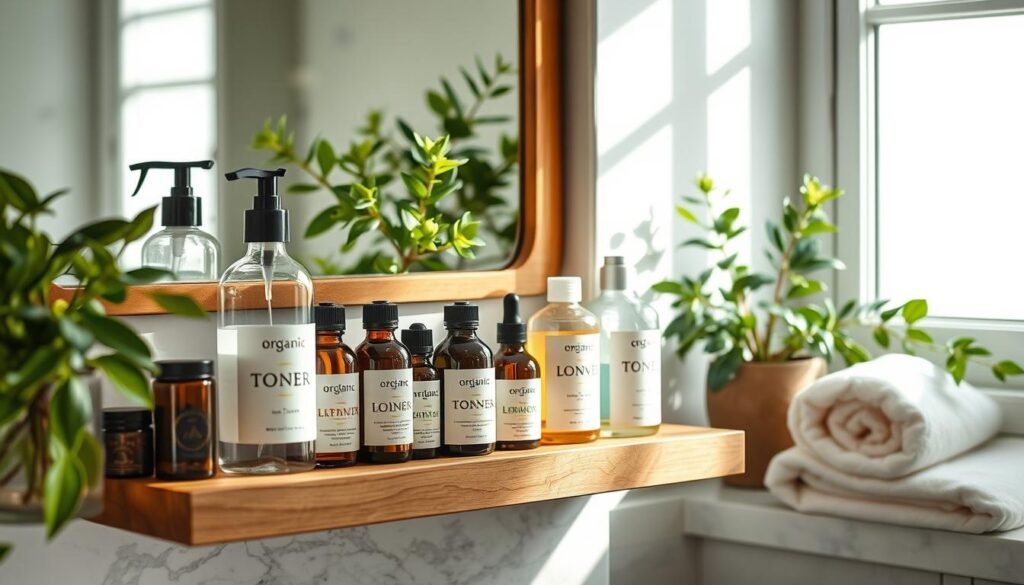
By adding toning to your non-toxic skincare routine and using plant-based products, you can get balanced and healthy skin14. Choose a toner that fits your skin type and concerns. Use it regularly to see the benefits15.
| Toner Type | Benefits |
|---|---|
| Hydrating Toner | Suitable for dry skin, helps retain moisture13 |
| Toner with Acne-Fighting Ingredients | Suitable for oily or acne-prone skin, helps reduce breakouts13 |
Moisturizing: Locking in Hydration
Moisturizing is key in any skincare routine. It locks in hydration and protects the skin from harm16. Choose a moisturizer that fits your skin type and needs. Look for ingredients like hyaluronic acid, which keeps water in the skin16.
Green beauty routines use eco-friendly products without harsh chemicals. Moisturize twice a day, morning and night17. If you have sensitive skin, use moisturizers without fragrances or dyes. Ingredients like chamomile and aloe vera are good choices17.
When picking a moisturizer, think about:
- How much hydration you need.
- The natural ingredients it contains.
- What works best for your skin type.
Using green beauty products and routines can make your skin healthy and bright. Moisturize right after bathing to keep your skin soft17. Drinking water also helps keep your skin hydrated from the inside out17.
| Skincare Step | Product Recommendation |
|---|---|
| Cleansing | Organic cleanser |
| Moisturizing | Eco-friendly moisturizer |
By following these tips and using eco-friendly products, you can support a healthy and green beauty routine18.
Sun Protection: Essential for All Skin Types
Sun protection is key in a clean beauty routine. Organic sunscreens help shield the skin from UV rays. The UV Index shows how much sun exposure there is, with higher numbers meaning more risk19. It’s best to stay out of the sun between 10 am and 4 pm, when it’s strongest19.
Choosing the right organic sunscreen is important. Look at the SPF number, which tells you how long it takes for your skin to burn20. There are different SPF levels, from low to very high20. Always apply sunscreen to your face, neck, and chest, and reapply often19.
Here are some sun protection tips:
* Use a water-resistant, broad-spectrum sunscreen with SPF 30 or higher every day20
* Apply sunscreen well and often, mainly during the hottest part of the day19
* Stay in the shade and avoid the sun’s peak hours19
* Wear protective clothes like hats and sunglasses to block the sun21
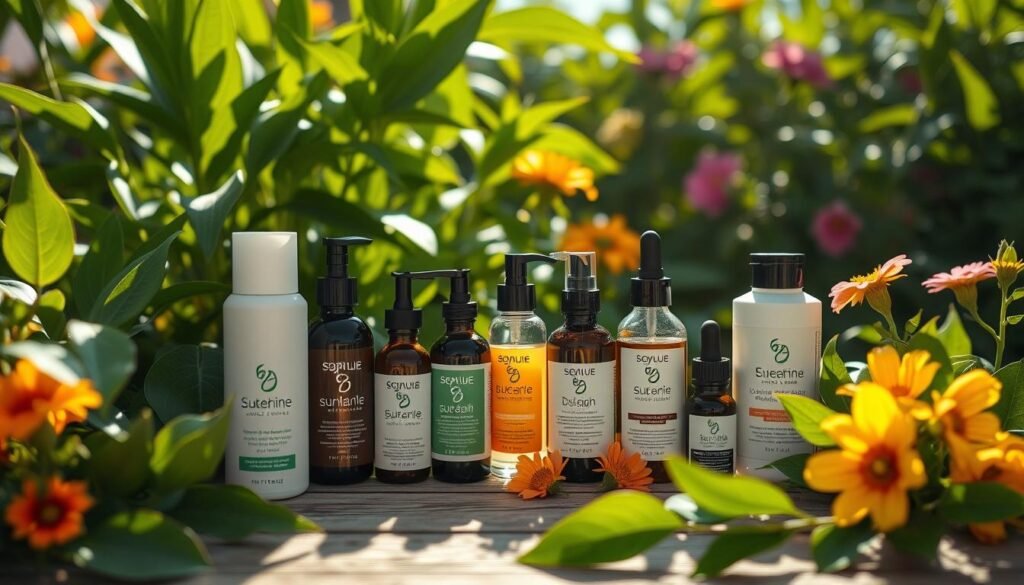
By following these tips and using organic sunscreens, you can keep your skin safe from the sun. This helps you maintain a healthy, radiant look21.
Special Treatments for Skincare Concerns
For a sustainable skincare routine, it’s key to add special treatments for specific skin issues. Plant-based skincare offers the needed nourishment and care. Organic serums, for instance, are packed with active ingredients. They deeply nourish the skin, brightening, hydrating, or exfoliating it22.
Masks are another great treatment for intense nourishment. They help with dryness, sensitivity, and more. Used 1-2 times a week for 15-20 minutes, masks target specific skin problems22. Hydrating serums, rich in natural ingredients, deeply nourish and hydrate the skin. They help with dryness, dullness, and fine lines when used daily22.
A sustainable skincare routine also includes a balanced diet. Eating foods rich in phytonutrients and antioxidants reduces body inflammation. This supports healthy skin23. Eating mostly organic fresh vegetables and legumes, and a bit of whole grains, is also good23.
By adding these special treatments and dietary changes, you can tackle specific skin concerns. This makes your skincare routine more sustainable and plant-based.
| Treatment | Benefits |
|---|---|
| Organic Serums | Brightening, hydrating, exfoliating |
| Masks | Nourishment, addressing skin concerns |
| Hydrating Serums | Nourishing, hydrating, benefiting dryness and fine lines |
The Role of Diet in Skincare
A balanced diet is key to healthy skin. It works well with green beauty routines and eco-friendly products. Foods full of antioxidants, vitamins, and minerals protect the skin and keep it healthy24. Eating a variety of whole foods, like leafy greens, berries, and fatty fish, gives the skin what it needs25.
Water-rich foods, like cucumbers and strawberries, help keep the skin hydrated24. Foods high in antioxidants, such as berries and leafy greens, shield the skin from harm24. Omega-3 fatty acids in salmon and walnuts help the skin stay flexible24. Vitamins A, C, and E in fruits and veggies help with cell renewal, collagen, and fighting damage25.
Drinking enough water is also vital for skin health. Aim for 8 glasses a day to avoid dryness and irritation26. Eating whole foods can also boost gut health, which may help with skin problems like acne and eczema24. Adding these foods to your green beauty routine and using eco-friendly products can lead to healthier, brighter skin.
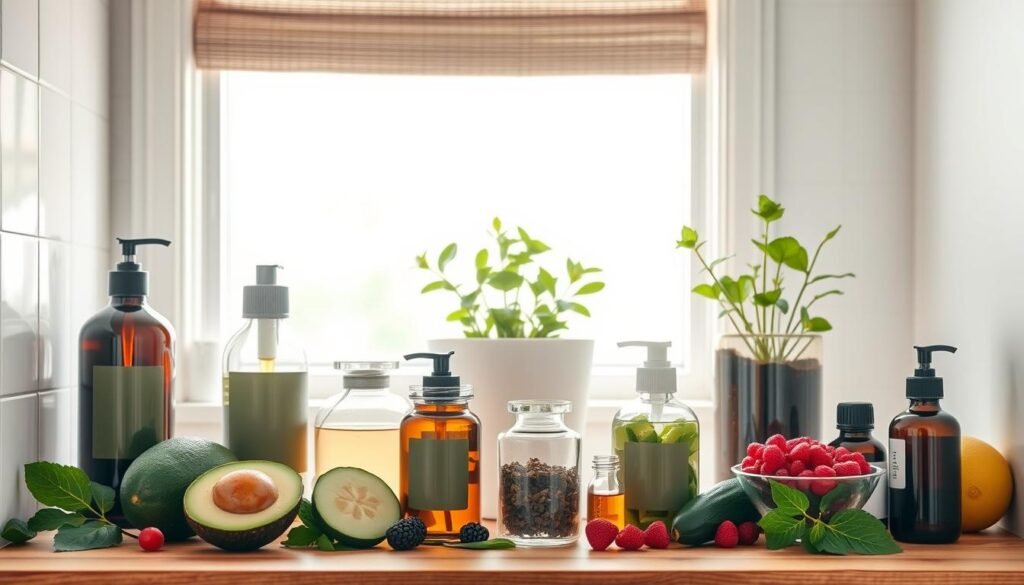
| Food | Nutrient | Skin Benefit |
|---|---|---|
| Leafy Greens | Vitamin A | Healthy cell turnover |
| Berries | Antioxidants | Protection from pollutants and UV damage |
| Fatty Fish | Omega-3 fatty acids | Supports skin elasticity |
Eco-Friendly Practices in Skincare
Choosing non-toxic skincare is good for your skin and the planet27. Look for products with eco-friendly packaging and ingredients from sustainable sources. For example, Trilipiderm offers products with minimal or recyclable packaging, reducing waste28.
Simple changes can make a big difference. Try using products until they’re empty or store bottles upside down to save money and reduce waste28. Also, switch to reusable cotton pads instead of single-use ones. This small change can help a lot.
More than half of consumers prefer sustainable beauty brands27. This demand is pushing the beauty industry to change. By choosing eco-friendly skincare, you help reduce harm to the environment and support positive change.
Want to learn more about eco-friendly skincare? Check out Trilipiderm’s blog. It offers tips on how to care for your skin while being kind to the planet.
Understanding Skin Types
To make an effective organic skincare routine, knowing your skin type is key. There are five main types: normal, oily, combination, dry, and sensitive293031. Each type has its own features, like how much oil it makes, pore size, and how it reacts to products.
Normal skin is balanced, with a smooth feel and small pores30. Oily skin makes too much oil, causing shine and big pores29. Dry skin is tight and rough because it lacks oil, while combination skin has both oily and dry spots31. Sensitive skin gets easily upset and doesn’t like some products29.
Finding out your skin type is important for picking the right natural skincare products. You can figure it out by watching how your skin reacts or using a blotting sheet29. Knowing your skin type lets you make a routine that meets your needs, helping your skin look its best.
Understanding your skin type and using the right natural skincare products can make your skin healthy and glowing. Always choose products that fit your skin type and stick to a consistent organic skincare routine for the best results30.
The Importance of Patch Testing
When you add new products to your clean beauty routine, patch testing is key to avoid bad reactions32. This step helps find out if a product might cause breakouts, redness, or peeling32. It’s vital for checking if a product fits your skin type and to prevent any issues33.
Plant-based skincare can be good, but it might not work for everyone, like those with sensitive skin33. To test safely, apply the product behind your ear or under your jaw. This way, you can hide any signs of a reaction33. It’s also important to watch for signs like redness, heat, itching, or stinging during and after the test33.
The American Academy of Dermatology (AAD) says over 15,000 things can cause allergic skin reactions34. Common ingredients like methylisothiazolinone and formaldehyde can cause problems34. To test, apply a small amount of the product to your skin and wait a few days to see if there’s a reaction34.
Adding patch testing to your routine helps make sure your plant-based skincare is safe and works well32. For more tips on choosing skincare products, check out healthyshopperplacer.com. It can help you make better choices for your skincare.
Listening to Your Skin
It’s key to pay attention to how your skin reacts to different products and routines. Notice any changes, good or bad, and adjust as needed. This way, you can craft a green beauty routine that suits your skin perfectly. Using eco-friendly skincare products can also reduce the chance of bad reactions and improve your skin’s health.
A tailored skincare routine can make your skin look better. It can reduce fine lines and wrinkles and make your skin look healthy and radiant. To get these results, listen to your skin and tweak your routine as needed. If a product works well, keep using it. But if it causes problems, stop and try something else.
Good signs your skin is doing well include better hydration, less redness, and a more even tone. By noticing these signs and adjusting your routine, you can make it work for you. Also, using natural ingredients like hyaluronic acid and rosehip oil can add benefits like deep hydration and gentle exfoliation35.
Remember, everyone’s skin is different. What works for one person might not work for another. So, be patient and flexible with your skincare routine. By listening to your skin and adjusting as needed, you can create a routine that makes your skin healthy and radiant. Keep using eco-friendly skincare products and a green beauty routine that fits your values and skin type36.
| Skincare Product | Benefits |
|---|---|
| Hyaluronic Acid | Deep hydration, plumping effect |
| Rosehip Oil | Gentle exfoliation, antioxidant properties |
Avoiding Harmful Ingredients
It’s key to know what’s in your skincare products. Our skin can soak up to 60% of what we put on it37. So, choosing non-toxic skincare is vital. Look for products without parabens, phthalates, sulfates, and synthetic fragrances37.
Switching to non-toxic products can help with skin issues like acne and aging37. But, natural products might not last as long because they lack synthetic preservatives37. Always check labels and look for the USDA Organic Seal. It means the product is mostly organic38.
Some brands, like Fields of Yarrow, focus on natural ingredients and last 12 months37. Consider handmade products from Josspure for sensitive skin39. Choosing non-toxic skincare reduces harmful chemical exposure and helps your skin glow.
For more tips on sustainable skincare, check out this resource. It talks about natural ingredients and how to pick the right skincare.
| Skincare Product | Ingredients | Certifications |
|---|---|---|
| Fields of Yarrow | Natural and organic ingredients | USDA Organic Seal |
| Josspure | Handmade and natural ingredients | No specific certifications mentioned |
DIY Organic Skincare Options
DIY organic skincare is a fun way to make your own natural skincare products. You can find simple recipes online. They use ingredients like coconut oil, shea butter, and essential oils40. These ingredients moisturize and protect your skin, key for a good organic skincare routine.
Popular DIY ingredients include coffee, bananas, and blueberries. They’re full of antioxidants and nutrients40. You can make face masks, scrubs, and moisturizers with them. Think about what’s easier: making your own or buying it41.
Here are some benefits of DIY organic skincare:
- Customization: Make products that fit your skin type and needs
- Cost-effective: Save money with natural ingredients
- Avoid harsh chemicals: Use organic ingredients to lower skin irritation risk
Adding DIY organic skincare to your organic skincare routine brings natural benefits and personalized products. Always test and follow safety rules when making and using DIY skincare40.
| Ingredient | Benefits |
|---|---|
| Coconut oil | Moisturizing and antioxidant properties |
| Aloe vera gel | Anti-inflammatory, antiseptic, and moisturizing properties |
Maintaining a Consistent Routine
Being consistent is key to getting and keeping healthy, glowing skin42. By doing a 21-day challenge, your skincare routine becomes a daily habit42. Experts say sticking to it is vital for lasting results43.
To stay on track, set reminders and make your skincare a self-care moment43. Treat yourself to a mini facial or a new organic product to stay motivated42. Having a friend or family member to share your goals adds accountability and support42.
Choosing quality products can make a big difference in your commitment42. There are also skincare apps to track your routine and remind you, making it easier42.
Remember, being consistent is the secret. Stick to your natural skincare routine, and you’ll get the healthy, glowing skin you want43.
FAQ
What constitutes organic skincare?
What are the benefits of using organic skincare products?
What are some key ingredients to look for in organic skincare?
What steps should be included in an effective organic skincare routine?
What types of organic cleansers are available, and how should they be used?
What are the different types of exfoliants, and how often should they be used?
What are the benefits of using organic toners, and what ingredients should be looked for?
How do you choose the right organic moisturizer for your skin type?
What should you look for in an organic sunscreen, and how should it be applied?
How can organic serums and masks provide targeted care for specific skin concerns?
How does diet and hydration impact the health of your skin?
What eco-friendly practices should be considered when choosing skincare products?
How can you identify your skin type and tailor your organic skincare routine?
Why is patch testing important when introducing new skincare products?
How do you know when to adjust your organic skincare routine?
What are some common harmful ingredients to avoid in skincare products?
When should you consider DIY organic skincare options, and when is it better to choose store-bought products?
How can you maintain consistency in your organic skincare routine?
Source Links
- The All-Organic Skincare Routine
- Nourish your skin: a guide to natural and organic skincare routine | NATRUE
- Natural, Botanical and Organic Skincare: What Are The Differences?
- Conscious Beauty Routine: The Best Natural Skin Care Products & Brands
- The 6 Best Natural & Organic Skincare Ingredients | Goodness Project
- Ultimate Guide to an Organic Skincare Routine – Nature’s Divine
- The Best Natural Skin Care Routine
- Everything You Need to Know to Start a Natural Skin Care Routine
- Four-Step Natural Skincare Routines for Morning and Night
- The Fresh Start and the First Step to your Clean Skin-Care Routine + TIps
- The Secret to Radiant Skin: The Essential Role of Exfoliation
- Glow Naturally: Benefits of Exfoliation for Radiant Skin
- Essential Step: Start Using Toner In Your Skincare Routine
- Natural Skin Care Routine that Saved my Skin
- Ultimate Guide to Balanced Skin Care Routine – theskinartistry
- Hydration vs. Moisture: What Does My Skin Need?
- The Importance of Moisturizing: Your Guide to Healthy, Hydrated Skin | Clear Skin Dermatology & Cosmetic Surgery
- Hydration Cream vs Water Lock
- The Secret to Youthful Skin: The Importance of Sunscreen in Your Daily
- Decoding Sunscreens: What SPF Should I Use?
- Sunscreen is The Most Important Part of Your Skin Care Routine
- The Ultimate 9-Step Natural Skin Care Routine
- The Basics of a Holistic Skincare Routine
- Nourish Your Skin from the Inside Out: Why Healthy Eating is Key to Skin Health | Texas Dermatology Specialists in Katy, TX
- Nutrition and Skin Health | Apex Skin Insights
- The Impact of Diet on Skin Health: Insights from Dermatologists – Metropolis Dermatology | James Wang, MD
- Nativa SPA – Nativa SPA
- Eco-Friendly Skincare Routine: Simple Steps to Success
- How To Identify Your Skin Type, According To a Dermatologist
- A guide to skin types
- Determining And Understanding Your Skin Type | The Skin Institute
- The Importance of Patch Testing New Skincare Products
- The Importance of Patch Testing.
- How to perform a patch test for skincare products
- The Non-Toxic Skincare Routine From My Pantry That Really Works
- The Ultimate Skincare Routine for Sensitive Skin in 2024
- Non-Toxic Skincare Routine – How To Get It Right
- Are Natural Skin Care Products Actually Better for Your Skin?
- No title found
- Six ingredients to include in a natural DIY skincare routine
- My Super-Simple All-Natural Skincare and Beauty Routine
- 15 Tips for a Consistent Natural Skincare Routine
- Why A Consistent Skincare Routine is Important — Samantha Linn Beauty + Wellness






